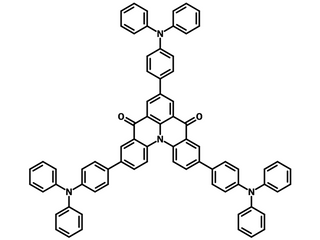MR-TADF Green Dopant with a DiKTa Core
High purity sublimed narrowband MR-TADF emitter for highly efficient OLEDs, Sublimed ≥99.0%
Specification | MSDS | Literature and Reviews
3TPA-DiKTa is a multiple resonance thermally activated delayed fluorescence (MR-TADF) green emitter with three electron donating triphenylamine (TPA) units attached at the opposite positions to the central nitrogen of the quinolino[3,2,1-de]acridine-5,9-dione (DiKTa) core.
TADF device based on 3TPA-DiKTa shows very high EQEmax of 30.8% at 552 nm (FWHM of 62 nm) when doped into 1,3-bis(N-carbazolyl) benzene (mCP), a maximum current efficiency (CEmax) of 117 cd/A, and maximum power efficiency (PEmax) of 108 lm W at 1.45 cd m-2.
When 4CzIPN is used as an assistant dopant, hyperfluorescence (HF) device based on 3TPA-DiKTa shows significantly improved efficiency roll-off and higher brightness. TADF-sensitized-fluorescence HF device demonstrates higher maximum luminance of 112,190 cd m-2 with low efficiency roll-off.
MR-TADF red emitter 3DPA-DiKTa and blue emitter Mes3DiKTa are also available in sublimed grade.
General Information
| CAS Number | N/A |
|---|---|
| Chemical Formula | C74H50N4O2 |
| Molecular Weight | 1027.21 g/mol |
| Absorption | λmax 494 nm (in toluene) |
| Fluorescence | λem 551 nm (in film) |
| HOMO/LUMO | HOMO = - 5.27 eV, LUMO = - 2.98 eV; ΔEST = 0.13 eV [1] |
| Synonyms | 3,7,11-Tris(4-(diphenylamino)phenyl)quinolino[3,2,1-de]acridine-5,9-dione |
| Classification or Family | DiKTa derivatives, Triphenylamines (TPA), Green dopant, Multiresonance thermally activated delayed fluorescent (MR-TADF), Sublimed materials. |
Product Details
| Purity | Sublimed* >99% (HPLC) |
|---|---|
| Melting Point | Mp > 400 °C |
| Appearance | Bright yellow powder/crystals |
* Sublimation is a technique used to obtain ultra pure-grade chemicals, see sublimed materials for OLED devices.
Chemical Structure

Device Structure(s)
| Device Structure | ITO (112 nm)/HATCN (5 nm)/TAPC (40 nm)/TCTA (10 nm)/mCP (10 nm)/2.0 wt.% 3TPA-DiKTa:mCP (20 nm)/TmPyPB (50 nm)/LiF (0.6 nm)/Al (100 nm) [1] |
|---|---|
| Color |
 Green light emission at 551 nm Green light emission at 551 nm |
| FWHM | 62 nm |
| Max Luminance | 36,400 cd m-2 |
| CIE Coordinates | (0.409, 0.577) |
| Max Current Efficiency | 117 cd/A |
| Max Power Efficiency | 108 lm/W |
| Max EQE | 30.8% |
| Device Structure | ITO/HATCN (5 nm)/TAPC (40 nm)/TCTA (10 nm)/mCP (10 nm)/10 wt % 4CzIPN and 2 wt. % 3TPA-DiKTa in mCP (20 nm)/TmPyPB (50 nm)/LiF (0.6 nm)/Al (100 nm) [1] |
|---|---|
| Color |
 Green light emission at 556 nm Green light emission at 556 nm |
| FWHM | 70 nm |
| Max Luminance | 112,190 cd m-2 |
| CIE Coordinates | (0.424, 0.551) |
| Max Current Efficiency | 106 cd/A |
| Max Power Efficiency | 111 lm/W |
| Max EQE | 30.0% |
MSDS Documentation
Literature and Reviews
- S. Wu et al. (2022); Highly Efficient Green and Red Narrowband Emissive Organic Light-Emitting Diodes Employing Multi-Resonant Thermally Activated Delayed Fluorescence Emitters, Angew. Chem. Int. Ed., 61 (52), e202213697; DOI: 10.1002/ange.202213697.
- J. Wang et al. (2024); Highly efficient organic light-emitting diodes and light-emitting electrochemical cells employing multiresonant thermally activated delayed fluorescent emitters with bulky donor or acceptor peripheral groups, Aggregate, 5 (5), e571; DOI: 10.1002/agt2.571.
